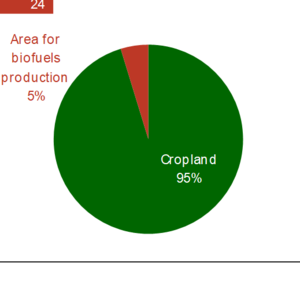Biofuels require little arable land but provide many benefits

January 9, 2020
BY UFOP
Although the share of land used for biofuel production increased by 1 percent in 2018, it remains very low. Crop plants are grown on more than 1.56 billion hectares worldwide. These include—among others—grain, oilseeds, protein, sugar and fiber plants, fruits, vegetables, nuts and others. Most of this produce is used as food. Only around 5 percent goes into biofuels production.
At the same time, biofuels production is in most cases very obviously located in places where there is a surplus of feedstock anyway. If the surplus were not used to produce biofuels, it would have to be placed on the global market, where it would weigh heavily on already low feedstock prices.
The use in biofuel production reduces the production overhang, generates extra value added and reduces the need for foreign currency for imports of crude or fossil fuels. The latter is primarily a problem in poorer countries.
Advertisement
Advertisement
Another advantage is the amount of high-quality protein feed that is generated in biofuel production, demand for which is steadily increasing. The amount and quality of these protein feeds have a strong influence on feedstock prices. Consequently, they also determine the amount of land dedicated to growing the feedstocks.
Thus, biofuels are by no means the price drivers in the commodities markets. If necessary, the feedstocks grown for biofuel production are primarily available for food supply. In the case of politically subsidized extensification, this option for “buffering” food demand is omitted.
Advertisement
Advertisement
Related Stories
The USDA significantly increased its estimate for 2025-’26 soybean oil use in biofuel production in its latest World Agricultural Supply and Demand Estimates report, released July 11. The outlook for soybean production was revised down.
U.S. fuel ethanol capacity fell slightly in April, while biodiesel and renewable diesel capacity held steady, according to data released by the U.S. EIA on June 30. Feedstock consumption was down when compared to the previous month.
The U.S. EPA on July 8 hosted virtual public hearing to gather input on the agency’s recently released proposed rule to set 2026 and 2027 RFS RVOs. Members of the biofuel industry were among those to offer testimony during the event.
The USDA’s Risk Management Agency is implementing multiple changes to the Camelina pilot insurance program for the 2026 and succeeding crop years. The changes will expand coverage options and provide greater flexibility for producers.
The USDA’s National Agricultural Statistics Service on June 30 released its annual Acreage report, estimating that 83.4 million acres of soybeans have been planted in the U.S. this year, down 4% when compared to 2024.
Upcoming Events










